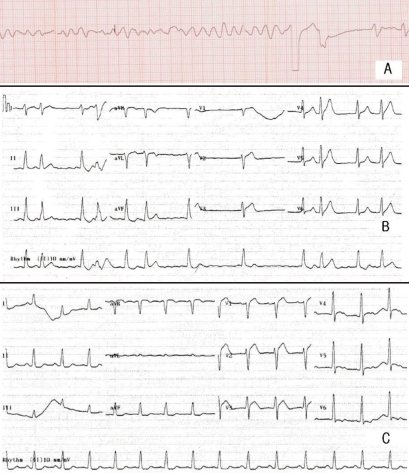Electrolyte Blood Press.
2011 Jun;9(1):27-31. 10.5049/EBP.2011.9.1.27.
Is There a Relationship between Hyperkalemia and Propofol?
- Affiliations
-
- 1Department of Internal Medicine, Hanyang University Guri Hospital, Guri, Korea. cardion@hanyang.ac.kr
- KMID: 1497139
- DOI: http://doi.org/10.5049/EBP.2011.9.1.27
Abstract
- This is a case of a sudden cardio-pulmonary arrest in a 29 year-old female, which occurred immediately after a large bolus infusion of propofol (100 mg) intravenously during dilatation and curettage. The arrest suddenly occurred, and the patient was eventually transferred to our emergency room (ER) on cardiopulmonary resuscitation. At that time, severe hyperkalemia up to 9.1 mEq/L and ventricular fibrillation were noted. Resuscitation in ER worked successfully with conversion of electrocardiograph to sinus rhythm, but this patient expired unfortunately. On view of this acute event immediately after the bolus injection of propofol accompanied without other identified causes, severe hyperkalemia induced by propofol was strongly assumed to be the cause of death. To our understanding with the literature survey, propofol as a cause of hyperkalemia has not been well described yet. Through this case, the relationship as a cause and an effect between propofol and hyperkalemia is suggested.
MeSH Terms
Figure
Cited by 1 articles
-
The Effects of Propofol and Thiopental Continuous Infusion on Serum Potassium Disturbances in Neurosurgical Patients
Tae Kyong Kim, Young-Jin Lim, Jae-Woo Ju, Jin Wook Kim, Hee-Pyoung Park
J Korean Neurosurg Soc. 2015;57(3):197-203. doi: 10.3340/jkns.2015.57.3.197.
Reference
-
1. Hatch DJ. Propofol-infusion syndrome in children. Lancet. 1999; 353:1117–1118. PMID: 10209973.
Article2. Bray RJ. Propofol infusion syndrome in children. Paediatr Anaesth. 1998; 8:491–499. PMID: 9836214.
Article3. Wolf A, Weir P, Segar P, Stone J, Shield J. Impaired fatty acid oxidation in propofol infusion syndrome. Lancet. 2001; 357:606–607. PMID: 11558490.
Article5. Fodale V, La Monaca E. Propofol infusion syndrome: an overview of a perplexing disease. Drug Saf. 2008; 31:293–303. PMID: 18366240.6. Kam PC, Cardone D. Propofol infusion syndrome. Anaesthesia. 2007; 62:690–701. PMID: 17567345.
Article7. Vasile B, Rasulo F, Candiani A, Latronico N. The pathophysiology of propofol infusion syndrome: a simple name for a complex syndrome. Intensive Care Med. 2003; 29:1417–1425. PMID: 12904852.
Article8. Ahlen K, Buckley CJ, Goodale DB, Pulsford AH. The 'propofol infusion syndrome': the facts, their interpretation and implications for patient care. Eur J Anaesthesiol. 2006; 23:990–998. PMID: 16938158.
Article9. Fudickar A, Bein B, Tonner PH. Propofol infusion syndrome in anaesthesia and intensive care medicine. Curr Opin Anaesthesiol. 2006; 19:404–410. PMID: 16829722.
Article10. Vernooy K, Delhaas T, Cremer OL, et al. Electrocardiographic changes predicting sudden death in propofol-related infusion syndrome. Heart Rhythm. 2006; 3:131–137. PMID: 16443524.
Article11. Ray BK, Vallejo MC, Creinin MD, et al. Amniotic fluid embolism with second trimester pregnancy termination: a case report. Can J Anaesth. 2004; 51:139–144. PMID: 14766690.
Article12. Castillo T, Avellanal M, Garcia de Lucas E. Bolus application of remifentanil with propofol for dilatation and curettage. Eur J Anaesthesiol. 2004; 21:408–411. PMID: 15141801.
Article13. Strickland RA, Murray MJ. Fatal metabolic acidosis in a pediatric patient receiving an infusion of propofol in the intensive care unit: is there a relationship? Crit Care Med. 1995; 23:405–409. PMID: 7867366.14. Oh MS. Disorders of potassium: Acid-base electrolytes. 2003. New York: Ohco. LLC;p. 146.15. Bonhomme V, Demoitie J, Schaub I, Hans P. Acid-base status and hemodynamic stability during propofol and sevoflurane-based anesthesia in patients undergoing uncomplicated intracranial surgery. J Neurosurg Anesthesiol. 2009; 21:112–119. PMID: 19295389.
Article16. Jackson MA, Lodwick R, Hutchinson SG. Hyperkalaemic cardiac arrest successfully treated with peritoneal dialysis. BMJ. 1996; 312:1289–1290. PMID: 8634622.17. Wasant P, Matsumoto I, Naylor E, Liammongkolkul S. Mitochondrial fatty acid oxidation disorders in Thai infants: a report of 3 cases. J Med Assoc Thai. 2002; 85(Suppl 2):S710–S719. PMID: 12403251.18. Bonhomme V, Demoitie J, Schaub I, Hans P. Acid-base status and hemodynamic stability during propofol and sevoflurane-based anesthesia in patients undergoing uncomplicated intracranial surgery. J Neurosurg Anesthesiol. 2009; 21:112–119. PMID: 19295389.
Article19. Zhou W, Fontenot HJ, Wang SN, Kennedy RH. Propofol-induced alterations in myocardial beta-adrenoceptor binding and responsiveness. Anesth Analg. 1999; 89:604–608. PMID: 10475288.
- Full Text Links
- Actions
-
Cited
- CITED
-
- Close
- Share
- Similar articles
-
- The Effects of Propofol and Thiopental Continuous Infusion on Serum Potassium Disturbances in Neurosurgical Patients
- Propofol-Related Infusion Syndrome in an Adult Patient Using Propofol Coma Therapy to Control Intracranial Pressure
- Hypokalemia and hyperkalemia
- Impaired aldosterone response to potassium and hyperkalemia in patients receiving a renin-angiotensin-aldosterone system inhibitor
- Spontaneous Sinus Conversion of Permanent Atrial Fibrillation During Treatment of Hyperkalemia


